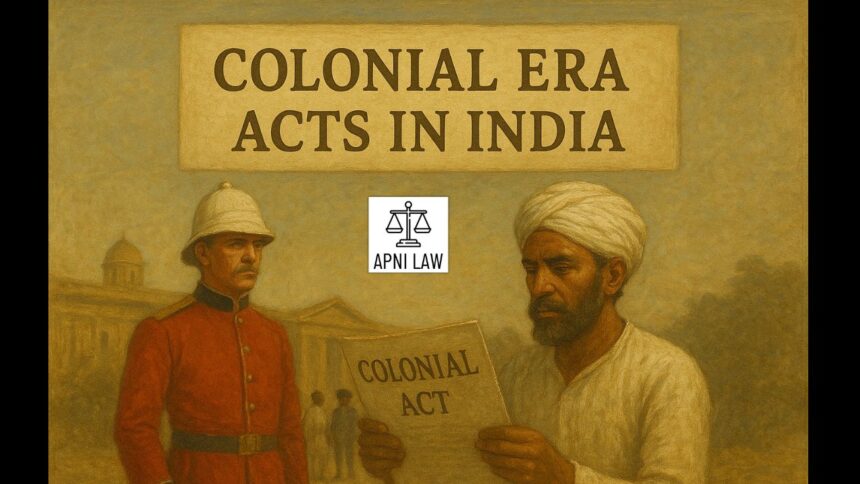Introduction
The Government of India Act 1935 stands as one of the most significant milestones in India’s constitutional history. Enacted during the final phase of British colonial rule, it introduced far-reaching reforms that shaped the structure of governance in India. While it fell short of granting complete self-rule, it laid down the groundwork for federalism and provincial autonomy, two principles that strongly influenced the drafting of the Indian Constitution.
This Act was not a sudden development. It came after a series of experiments with limited self-governance under earlier laws like the Indian Councils Acts and the Government of India Act 1919. The demand for more Indian participation in governance, coupled with the British attempt to retain control, gave birth to the 1935 Act. Despite its flaws, it was the longest and most comprehensive law passed by the British Parliament for governing India.
Background to the 1935 Act
The seeds of the 1935 Act were sown in the Simon Commission Report (1930), which recommended constitutional reforms, and the discussions at the Round Table Conferences held between 1930 and 1932. These conferences were attended by Indian leaders and British officials to deliberate on India’s political future. Although the talks often ended in deadlock, they highlighted the urgent need for a new constitutional framework.
The failure of the 1919 Act to satisfy Indian aspirations and the growing nationalist movement pushed the British to propose new reforms. The White Paper of 1933, which compiled suggestions from the Round Table Conferences, became the basis of the Government of India Act 1935.
Key Features of the Act
The Government of India Act 1935 was an elaborate document, consisting of 321 sections and 10 schedules. Its main features revolved around two critical aspects, federalism and provincial autonomy.
Federal Scheme
The Act proposed a federation of India that would include provinces of British India and princely states. British provinces such as Bombay, Bengal, and Madras were to join automatically, while princely states could voluntarily accede by signing an instrument of accession.
The federal legislature was to be bicameral, consisting of the Federal Assembly and the Council of States. Representation was based on communal and class electorates, continuing the divisive system of separate electorates introduced earlier.
Although the scheme looked promising on paper, it never came into effect because the princely states refused to join the federation. The rulers feared losing their autonomy and were reluctant to integrate with British provinces under a central government.
Provincial Autonomy
One of the most important aspects of the 1935 Act was the introduction of provincial autonomy. It replaced dyarchy, which had been introduced in the provinces under the 1919 Act. Under provincial autonomy, elected ministers were given full control over subjects such as education, health, agriculture, and local government.
The governor retained special powers, including the ability to veto legislation and dismiss ministries, but in practice, provincial governments enjoyed a much larger degree of self-rule than before. This change allowed Indian leaders to administer provinces under the British framework. For instance, Congress formed governments in several provinces after the 1937 elections, giving Indian politicians real experience in governance.
Division of Powers
The Act introduced a three-fold division of powers: federal, provincial, and concurrent lists. Matters of national importance like defense and foreign affairs were kept with the federal government, while subjects like police and education went to the provinces. Concurrent subjects, such as criminal law, could be legislated upon by both levels. This division influenced the Indian Constitution’s distribution of powers under Union, State, and Concurrent Lists.
Other Provisions
The Act extended separate electorates to more groups, including women, laborers, and business communities. It also established the Reserve Bank of India to manage currency and credit. Moreover, the Federal Court was set up in 1937 to resolve disputes between the center and provinces.
Criticism of the 1935 Act
While the Act introduced significant reforms, it was heavily criticized for its limitations. The federal scheme failed because princely states did not join, rendering the plan ineffective. The division of powers gave governors overriding authority, which often undermined provincial autonomy. The continuation and expansion of separate electorates deepened communal divisions and paved the way for political polarization.
Nationalist leaders like Jawaharlal Nehru criticized the Act as a tool to divide Indians further, while B.R. Ambedkar viewed it as a halfway measure that gave Indians limited powers without true sovereignty. Mahatma Gandhi dismissed it as unworkable, though he encouraged Indian leaders to use whatever space it created to advance self-rule.
Significance of the 1935 Act
Despite its shortcomings, the Government of India Act 1935 holds immense significance in India’s constitutional journey. Provincial autonomy gave Indian leaders practical training in governance, preparing them for the responsibilities of independence. Institutions like the Reserve Bank of India and the Federal Court laid the foundations for modern financial and judicial systems.
The Act’s federal scheme, though never implemented, became the basis for the federal structure adopted in the Indian Constitution of 1950. Many provisions of the 1935 Act were directly carried into the Constitution, reflecting how the Act acted as a bridge between colonial rule and full democracy.
Frequently Asked Questions
Why was the Government of India Act 1935 significant?
The Act was significant because it introduced provincial autonomy and proposed a federal structure. It gave Indian leaders their first real opportunity to govern provinces and influenced many provisions of the Indian Constitution.
Why did the federal scheme under the 1935 Act fail?
The federal scheme failed because princely states refused to join the federation. They were unwilling to surrender their autonomy and feared domination by British provinces.
How did the 1935 Act contribute to India’s independence movement?
The Act gave Indian leaders administrative experience, which prepared them for governance after independence. At the same time, its limitations strengthened the demand for complete freedom rather than partial reforms.
Conclusion
The Government of India Act 1935 was a turning point in India’s constitutional history. Although flawed and incomplete, it introduced the principles of federalism and provincial autonomy that became cornerstones of independent India’s governance. Its significance lies not in what it achieved during British rule, but in how it prepared India for self-government.
By giving Indians a chance to govern provinces and by creating institutions that lasted beyond colonial rule, the Act became an important precursor to the Constitution of India. In this way, the 1935 Act remains a crucial chapter in the story of India’s march toward democracy and sovereignty.
For any specific query call at +91 – 8569843472







